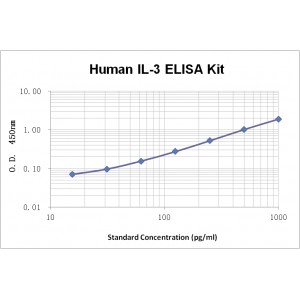More info
Assay Range | 15.6--1000 pg/mL |
Sensitivity | 1.0 pg/mL |
Specificity | No cross-reaction with other related substances detected |
Size | 96T |
Storage | Store at 2 - 8ºC. Keep reconstituted standard and detection Ab at -20 ºC |
Assay Principle | Sandwich ELISA |
Sample Volume | 100 µL final volume, dilution factor varies on samples |
Sample Type | serum, plasma or cell culture supernatant |
Detection Method | Chromogenic |
Kit Components
1. Recombinant Human IL-3 standard: 2 vials
2. One 96-well plate coated with Human IL-3 Ab
3. Sample diluent buffer: 12 mL - 1
4. Detection antibody: 130 µL, dilution 1:100
5. Streptavidin-HRP: 130 µL, dilution 1:100
6. Antibody diluent buffer: 12 mL x1
7. Streptavidin-HRP diluent buffer: 12 mL x1
8. TMB developing agent: 10 mL x1
9. Stop solution: 10 mL x1
10. Washing solution (20x): 25 mL x1
Background
Interleukin 3 (IL-3), also known as hematopoietic growth factor, Mast cell growth factor (MCGF), multi potential colony-stimulating factor, P-cell-stimulating factor, is a cytokine belonging to the IL-3 family. Human IL-3 precursor consists of a 19 amino acid (aa) signal peptide and a 133 (aa) mature polypeptide. IL-3 is expressed by several hematopoietic and non-hematopoietic cell types including activated human T cells, natural killer cells, mast cells, epithelial cells, stromal cells, murine keratinocytes, neurons and astrocytes. Human IL-3 is 29% identical to mouse IL-3. IL-3 binds to a heteromeric transmembrane receptor complex consisting of α (IL-3 Rα) and common β (βc) subunits. The βc subunit is shared with IL-5 and GM-CSF, while the IL-3 Rα subunit is specific for IL-3. Human IL-3 plays a key role in stimulating the proliferation, differentiation, and survival of pluripotent hematopoietic stem cells as well as various lineage-committed progenitors.


